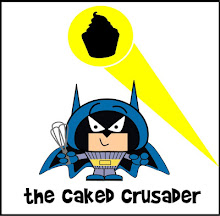
It’s the CCD’s (Caked Crusader’s Da) birthday on the 28th April. It’s also my uncle’s birthday which isn’t all that surprising seeing as they’re twins!
OK, so I can't explain what happened on the "T" in birthday; it took on a life of its own!

The CCD is rather partial to coffee cake and swiss meringue buttercream so I took a recipe for Austrian coffee cake and teamed it up with my trusted recipe for swiss meringue buttercream. The cake was particularly interesting to me as it used a technique that I’ve only previously seen with lemon cake, that of making a syrup to drizzle over and be absorbed by the fresh-from-the-oven cake to guarantee maximum flavour and moistness. I suppose it isn’t dissimilar to the technique used for making tiramisu. Here’s the sponge after the syrup was brushed over:

The original quantities for the sponge layers looked a bit mean to me so I scaled the recipe up, hence the oddly exact looking volumes. I find that all sponges are scalable and you shouldn’t ever fear doing this. My quantities are 150% of the original (except for the eggs, where I scaled three up to five) and gave a lovely tall sponge.
Candles can be used to express that special heartfelt message (this is probably an appropriate place to explain that my family are all blessed with the same "unusual" sense of humour - I think the candles were the CCD's favourite part of the cake!):


It’s a tricky cake to cut and get crisp, neat slices but no one seemed to mind!

These photos show how the sponge absorbs pockets of coffee syrup and stays extremely moist:

Happy birthday CCD and Nunks!
Ingredients:
For the sponge cake:
75g walnuts, finely chopped
263g self raising flour
2 ½ teaspoons baking powder
263g unsalted butter, at room temperature
263g golden caster sugar
5 eggs
2 ½ level tablespoons instant espresso coffee powder (I used Nescafe) mixed with 3 tablespoons boiling water
For the syrup:
1 ½ level tablespoons instant espresso coffee powder
75g Demerara sugar
83ml boiling water
For the swiss meringue buttercream:
4 egg whites
250g caster sugar
250g unsalted butter
2 level tablespoon instant espresso coffee powder mixed with slightly less than 1 tablespoon boiling water
How to make:
- Preheat the oven to 170°C/fan oven 150°C/325°F/Gas mark 3.
- Line two 20cm round sandwich tins with baking paper.
- Beat together all of the ingredients except for the coffee and walnuts. Ensuring that your butter is soft will make this task easier.
- Add the coffee and walnuts and beat further until the mixture is well combined.
- The mixture should drop from the spoon when tapped on the bowl. If it doesn’t add a little more hot water.
- Divide the mixture evenly between the two prepared tins and bake for approximately 30 minutes or until a skewer comes out clean. Mine took 40 minutes.
- While the cakes are cooking, make the syrup: place the coffee and sugar in a heatproof bowl and then add the boiling water.
- Stir until both the coffee and sugar have dissolved. You will need to stir briskly to ensure this.
- When the cakes are cooked, leave in the tins, on a wire rack.
- Prick them all over – while they are still hot – and spoon the syrup over both sponges, trying to distribute it as evenly as possible. I found this a lot easier to achieve using a silicon pastry brush and gently brushing the syrup over the sponges.
- Leave the cakes in the tin to absorb the syrup and only remove when completely cool. Take care as a moist cake is a fragile cake.
- Now make the swiss meringue buttercream. Place the egg whites and sugar in a bowl over a pan of simmering water. Stir pretty much constantly to prevent the egg from cooking.
- After 5-10 minutes, when the sugar has dissolved (when you cannot see any crystals on the back of the spoon), remove the bowl from the pan of simmering water and whisk until the meringue has puffed up and the mix is cool.
- Add the butter and coffee to the meringue and whisk until the butter has been completely incorporated into the meringue. At first it will look a disaster – it will collapse and look curdled but don’t worry! Stop when the mixture is smooth, light and fluffy.
- Spread approximately a third of the buttercream on top of one of the sponges and then put the other sponge on top.
- Use the remaining buttercream to cover the top and sides as desired.
- Bask in glory at the wonderful thing you have made.
- Eat.










































